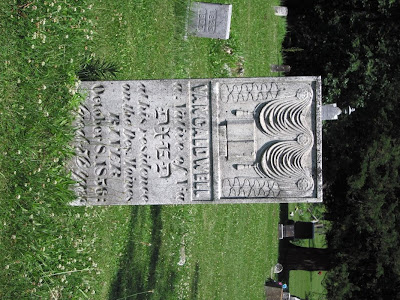
I really like Van Caldwell’s tombstone at the Iowaville Cemetery --- and surely would like to find Daniel McMullen’s, which seems to have vanished, another of the minor mysteries this place specializes in.
Caldwell was a Virginian who arrived at Iowaville about 1839 after living at Bentonsport with his family for a year or two. One of his sons, Henry Clay Caldwell --- lawyer, Civil War colonel from Iowa who was named an Arkansas judge by Lincoln, prominent citizen of Little Rock where he died in 1915 --- kind of overshadowed his dad and got most of the press. But there are a few sketchy references to Van Caldwell out there.
Van is described in one of many biographical references to his son as “at one time, a wealthy Virginia planter, (who) meeting reverses in fortune, and losing the greater part of his estate, sold his ancient homestead and came to Iowa, which was then a territory. … He was an old-style Virginia gentleman.”
When the Caldwells arrived at Iowaville, they settled northwest of the village --- inadvertently claiming land in a small triangular area north of the Des Moines River that at the time was still Sac and Fox territory but became Davis County. They weren’t supposed to be there.
The first survey map of the area, which dates from about 1840, notes the Caldwell cabin’s location in Section 2 of what became Davis County, roughly an eighth of a mile due north of Black Hawk’s grave and the same distance east of the river. This was about a mile and a quarter northwest of Iowaville.
John Beach, who succeeded his father-in-law, Gen. Joseph M. Street, as agent to the Sac and Fox upon Street’s death at Agency in 1840, explains why the Caldwell family was allowed to remain:
"Through some unfortunate misunderstanding in regard to the boundary line, several persons had intruded upon the Indian land upon the Iowaville bottom and the ridges in the rear, as well as upon the south side of the river; and as the Indians made complaint to the Government, it had no alternative but to remove them. This duty fell upon the writer to execute, and was a very unwelcome one, if only for the reason that several of the intruders were persons who would not willingly have violated any law. Among them was that fine old specimen of West Virginia hospitality, Van Caldwell; but by reason of his location, and his readiness by any reasonable arrangement to escape the terrors of fire and sword, the writer obtained permission from the Department that he should remain, upon the condition of his maintaining a ferry for access to Soap Creek Mills during high water.”
As a result, Van sometimes is noted as the first Iowan licensed to operate a ferry in the state.
Caldwell’s first wife reportedly was Susan Moffit, but she apparently had died elsewhere and Van married a substantially younger woman, Rachel, who shares the Caldwell lot at Iowaville with Van and three of their children, all of whom died very young.

Rachel died 29 April 1854, age 29 years, 8 months and 21 days, apparently while giving birth to a daughter, Belle R. Their children were Adeline, died 16 February 1847, age 5 days; Belle, died 5 October 1852, age 1 year, 10 months and 23 days; and Belle R., who survived her mother by a couple of months before dying on 15 July 1854, age 2 months and 15 days. (Note that Belle R.'s tombstone has fallen and I did not photograph it.)
Van himself died 8 October 1856, “at his residence on the Des Moines River” as the tombstone inscription records. He was 56.
While a good deal of information can be found about Van Caldwell, that is not the case with Daniel McMullen (sometimes spelled McMullin).
The 1878 history of Van Buren County lists William McMullen, a bachelor, among Iowaville’s first settlers. That history also contains the statement that “The demise of Daniel McMullen was the first in the place (Iowaville).”
WPA workers located Daniel’s tombstone in the Iowaville Cemetery at some point during the 1930s, reporting that it contained an inscription stating that he died 18 August 1841 and indicated that he had been born during 1797.
Van Buren County D.A.R. members, working in 1936, recorded the same date of death and the notation that Daniel was 44 when he died.
At some point a more complete description of Daniel’s monument, which sounds as if it were a table tomb, entered the literature regarding Iowaville Cemetery --- and it’s been repeated again and again.
That description has most recently been repeated in a new book entitled “Van Buren County, Iowa: A Pictoral History,” published by Villages of Van Buren County in 2007.
The description of Daniel’s monument (page 68) reads, “One of the most pretentious tombs belongs to Daniel McMullen, an early day trader with the Indians. The McMullen tomb, walled up with stone, is topped by a slab about seven by four feet. The name, “Daniel McMullen,” the date “August 18, 1841,” and age “44 years,” are inscribed above a bas-relief insignia that resembles the Masonic square and compass but is a crossed Indian arrow and tomahawk.”
The difficulty is, that tomb just isn’t there. And what became of it I cannot say.
Although I do have a theory: That Daniel is in Black Hawk's grave. To phrase that another way, that the current somewhat peculiar monument to Black Hawk was constructed on the ruins of Daniel McMullen's table tomb because of a misunderstanding about just who was buried there. More about that another time.

No comments:
Post a Comment